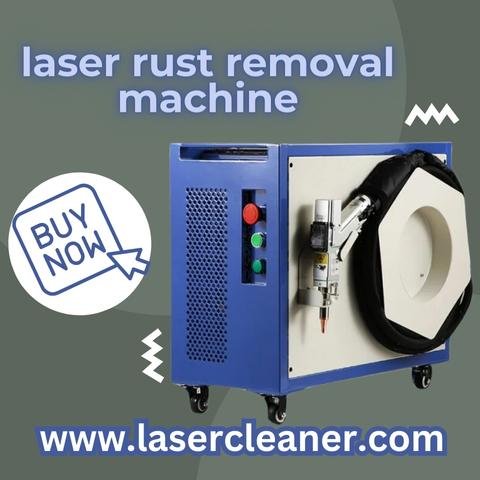How a Laser Rust Removal Machine Works Without Touching Metal

When you think about removing rust from metal, traditional methods like sandblasting, chemical treatments, or manual scrubbing probably come to mind. These techniques require direct contact with the surface, often leading to material loss, environmental concerns, or labor-intensive efforts. But what if there was a way to eliminate rust without physical contact? Enter the laser rust removal machine—an advanced technology that cleans metal surfaces effortlessly, precisely, and without a single touch.
The Science Behind Laser Rust Removal
A laser rust removal machine operates on the principle of laser ablation. The process involves directing a high-intensity laser beam onto the rusted surface. The laser’s energy is absorbed by the rust (iron oxide) but not by the underlying clean metal. This selective absorption causes the rust to vaporize instantly, leaving the base material unharmed.
Unlike mechanical methods that scrape away layers of metal or chemical treatments that introduce hazardous waste, laser rust removal is a non-contact, non-abrasive solution. The laser’s precision ensures that only the contaminated layer is removed, preserving the integrity of the original metal.
Why Traditional Methods Fall Short
Before the advent of laser rust removal machines, industries relied on methods like:
-
Sandblasting: Effective but causes surface wear, generates dust, and requires extensive cleanup.
-
Chemical Stripping: Harsh acids dissolve rust but pose health risks and environmental hazards.
-
Wire Brushing/Grinding: Labor-intensive and often damages the metal underneath.
These techniques not only risk damaging the workpiece but also demand significant time and resources. A laser rust removal machine eliminates these drawbacks by offering a cleaner, faster, and more efficient alternative.
Applications Across Industries
The versatility of laser rust removal machines makes them invaluable in various sectors:
-
Automotive Restoration: Classic car enthusiasts use lasers to strip rust from vintage parts without altering the original metal.
-
Aerospace Maintenance: Precision is critical—lasers remove corrosion from aircraft components without compromising structural strength.
-
Marine Industry: Saltwater accelerates rust; laser cleaning prolongs the lifespan of ship hulls and offshore equipment.
-
Historical Artifact Preservation: Museums employ lasers to restore ancient metal artifacts without physical contact.
-
Manufacturing & Fabrication: Factories use lasers to prepare metal surfaces for welding or coating, ensuring optimal adhesion.
How It Compares to Other Technologies
While other rust removal technologies exist, none match the precision and safety of a laser rust removal machine. For instance:
-
Ultrasonic Cleaning: Effective for small parts but limited to submerged objects.
-
Electrolysis: Removes rust through chemical reactions but requires conductive solutions and electrodes.
-
Plasma Cleaning: Works well but is less precise and more expensive than laser systems.
Laser technology stands out because it requires no consumables (like sand or chemicals), produces no secondary waste, and can be automated for large-scale operations.
The Environmental Edge
One of the most compelling advantages of a laser rust removal machine is its eco-friendliness. Traditional methods generate toxic residues, airborne particles, or chemical runoff. In contrast, laser cleaning converts rust into fine particles that can be easily captured by filtration systems, leaving no harmful byproducts. This makes it an ideal choice for industries aiming for sustainable and compliant operations.
Cost-Effectiveness Over Time
While the initial investment in a laser rust removal machine may seem high, the long-term savings are substantial. Consider:
-
Reduced Labor Costs: Automated laser systems require minimal human intervention.
-
No Consumables: Unlike sandblasting (which needs abrasive media) or chemical treatments (which require replenishment), lasers operate without ongoing material costs.
-
Lower Waste Disposal Fees: With no toxic waste, disposal expenses are negligible.
-
Extended Equipment Life: By preserving the base metal, lasers reduce replacement frequency.
Safety and Operator Benefits
Unlike abrasive blasting or chemical dipping, laser rust removal poses minimal health risks. Operators are not exposed to flying debris, toxic fumes, or skin-irritating substances. Modern laser rust removal machines come with safety features like enclosed work areas, fume extractors, and protective eyewear to ensure compliance with workplace safety standards.
Customization and Scalability
Whether you’re working on delicate jewelry or massive industrial machinery, laser rust removal machines can be tailored to fit the job. Adjustable power settings, beam sizes, and scanning patterns allow for customization based on material thickness, rust severity, and desired finish. For large-scale operations, robotic laser systems can be integrated into production lines for continuous cleaning.
Future of Rust Removal
As industries shift toward automation and green technologies, the demand for laser rust removal machines will only grow. Innovations like portable handheld lasers and AI-assisted scanning are already emerging, making the technology more accessible and efficient.
Final Thoughts
The laser rust removal machine is revolutionizing how industries approach metal cleaning. By combining precision, efficiency, and environmental responsibility, it outperforms traditional methods in nearly every aspect. Whether you're restoring a vintage car, maintaining critical aerospace components, or streamlining factory operations, this technology offers a smarter way to eliminate rust—without ever touching the metal. If you're looking for a cutting-edge solution that saves time, money, and the planet, it’s time to embrace laser rust removal.





